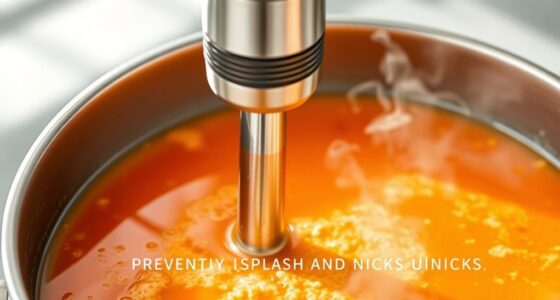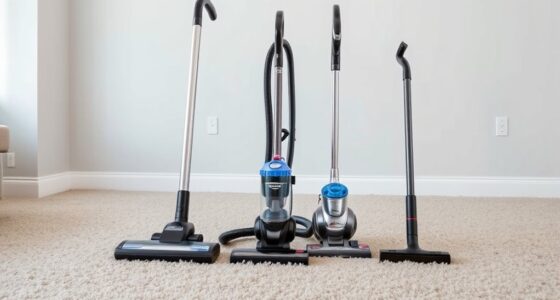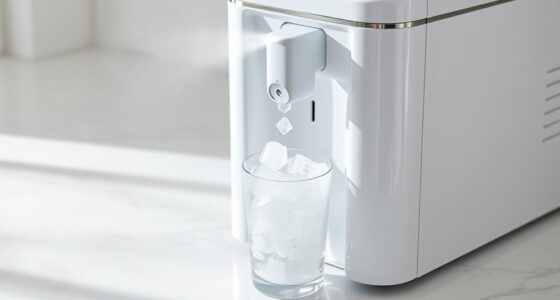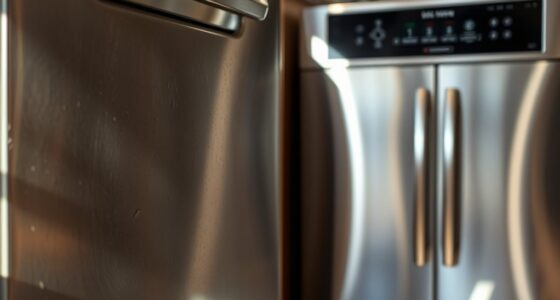If you’re looking to neutralize odors during vacuuming, both baking soda and activated charcoal can help, but they work differently. Baking soda absorbs surface and mild odors and can be sprinkled directly or placed in problem areas, making it a quick fix. Charcoal, with its high surface area, offers a more powerful, lasting solution for deep-seated smells like pet or smoke odors. To get the best results, understanding how each works will make your odor control efforts more effective—discover how to optimize their use.
Key Takeaways
- Activated charcoal provides more powerful, long-lasting odor absorption than baking soda, especially for deep-seated smells.
- Baking soda is safer, more affordable, and easier to apply directly on surfaces, while charcoal is typically used in filters or bags.
- Charcoal’s high surface area attracts and traps a broader range of odors, including pet, smoke, and cooking smells.
- Baking soda mainly neutralizes surface and mild odors and is less effective against persistent or embedded odors.
- Combining baking soda with vacuuming or using charcoal filters enhances overall odor control effectiveness.
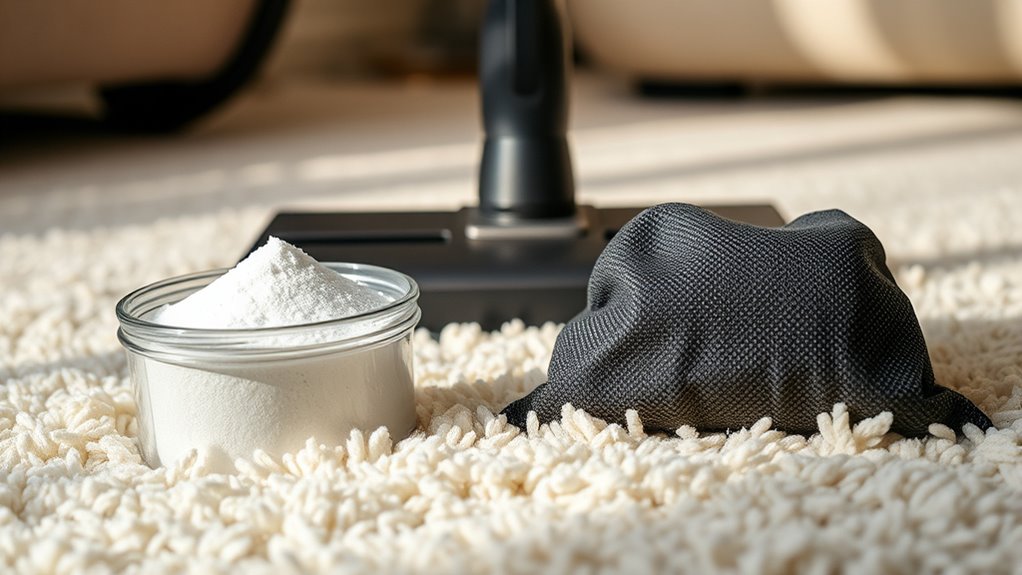
If you’ve ever struggled with lingering odors after vacuuming, you’re not alone. It’s frustrating to finish cleaning and still notice a stale or unpleasant smell hanging in the air. Luckily, there are simple solutions to improve scent absorption and freshen your space. One effective method involves using an air purifier, which can considerably reduce airborne odors. But if you prefer a more natural approach, incorporating odor absorbers like baking soda or charcoal can make a big difference. These substances are known for their ability to trap and neutralize bad smells, making your home feel fresher after each vacuuming session.
When it comes to scent absorption, baking soda is a classic choice. Its porous structure absorbs odors rather than just masking them. You can sprinkle baking soda directly onto carpets or use it in vacuum bags or filters. When vacuuming, the baking soda particles are released into the air, trapping odor molecules and preventing them from lingering. This method is simple, cost-effective, and safe for most households. Plus, baking soda is versatile—you can also leave a box open in problem areas to continuously absorb odors over time. However, keep in mind that baking soda’s scent absorption capacity is limited to surface odors and less effective against persistent or deep-seated smells.
Charcoal, especially activated charcoal, offers a more powerful alternative for scent absorption. Its highly porous surface provides an enormous surface area that attracts and holds odor molecules more efficiently than baking soda. Many air purifiers incorporate activated charcoal filters precisely because of this capability. When used in conjunction with a vacuum, charcoal can absorb a broader range of odors, including pet smells, cooking fumes, and smoke. You can also buy charcoal bags or filters designed specifically for scent absorption, placing them near vacuum outlets or inside vacuum bags to enhance odor control. Unlike baking soda, activated charcoal doesn’t require direct contact with surfaces; instead, it works by pulling odors from the air, providing a more thorough and lasting freshening effect.
Frequently Asked Questions
Can Vacuum Odor Control Methods Harm Sensitive Respiratory Conditions?
You should be cautious, as vacuum odor control methods like baking soda and charcoal can impact respiratory safety, especially if you have sensitive conditions. Fine particles may become airborne, posing allergy risks and aggravating symptoms. Always guarantee proper ventilation during vacuuming, use HEPA filters if possible, and avoid inhaling dust directly. These precautions help protect your respiratory health while managing odors effectively.
How Often Should I Replace Baking Soda or Charcoal for Effective Odor Control?
You should replace baking soda or charcoal every 30 days for maximum odor control. The effectiveness duration of both materials decreases over time, so regular replacement ensures they keep absorbing odors effectively. If you notice persistent smells before a month, consider replacing them sooner. Consistent replacement maintains freshness and prevents odors from building up, especially if you have pets or frequent vacuuming.
Are There Any Safety Concerns When Using These Odor Absorbers Around Pets?
Like walking a tightrope, you need to be cautious with pets around odor absorbers. Baking soda and charcoal are generally safe, but direct contact or ingestion could cause issues. Keep them out of your pet’s reach to prevent accidental chemical exposure. Always supervise, and opt for pet-safe containers. Your pet’s safety depends on proper placement and storage, so stay vigilant to avoid any risks.
Do Different Vacuum Models Impact the Effectiveness of Odor Control Methods?
Different vacuum models do impact odor control effectiveness because vacuum compatibility affects how well odor absorbers like baking soda or charcoal work. If your vacuum’s filter or design isn’t compatible, it can reduce odor absorption efficiency, making it less effective at neutralizing smells. To maximize results, choose a vacuum suited for odor control, ensuring it has good airflow and compatible filters that support the absorption process.
Can Combining Baking Soda and Charcoal Improve Overall Odor Elimination?
Combining baking soda and charcoal can boost odor absorption and air purification in your vacuum. For example, placing a small bowl of baking soda inside your vacuum bag alongside charcoal can trap more odors effectively. This synergy enhances overall odor elimination, reducing stubborn smells better than using either alone. You get fresher air and a cleaner home, making your vacuuming more effective in controlling pet, smoke, or musty odors.
Conclusion
In the end, both baking soda and charcoal are your trusty allies in fighting odors, like two sides of the same coin. Baking soda is quick and easy, absorbing smells like a sponge soaking up water, while charcoal offers long-lasting freshness, acting like a silent guardian. Choose based on your needs, but remember, like a good friend, the right odor control method makes your home feel fresh and welcoming every time.


